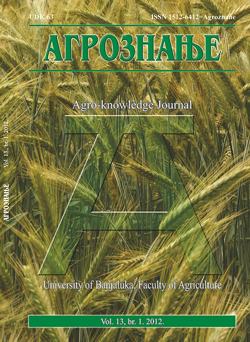Risky periods of pesticide (insecticide and fungicide) pollution of vegetables grown in greenhouses
DOI:
https://doi.org/10.7251/AGREN1201153DAbstract
Owing to the need of the population to consume vegetables in winter and spring (December-May), the production of vegetables grown in greenhouses is increasing, covering larger and larger areas. In order to protect vegetables from economically important pests, we often use a wide range of pesticides which are dangerous for the health of consumers. In connection with this, the observations in greenhouses with tomatoes and cucumbers were provided in three regions of the country, namely the following towns: Rakovski, Plovdiv and Perustitsa. During the whole vegetation period, phytosanitary status in the greenhouses was checked every week by reviewing individual plants. By growing-up tomatoes in glass greenhouses during the period from January to July, the following diseases were reported as predominant: Botrytis cinerea pers. and Alternaria porri f.sp.splani E et M., and pollution of the production was caused by fungicides. During the harvest, significant problems were caused by the pests: Myzodes persicae Sulz, Macrosiphum euphorbiae Thom., Liriomyza bryoniae Kalt. and the pollution was mainly by insecticides. As regards the cucumbers, grown in steel-glass greenhouses during the period from January to July, the problems of phytopathological character predominated: Fusarium, Erysiphe cichoracearum De Candolle, Pseudoperonospora cubensis Rostovzew. This imposed treatments more often and the pollution during that period was caused mainly by fungicides. The results obtained can be used for various technological solutions for the purpose of reducing the risk posed by the residual quantities of pesticides in the vegetables grown.Downloads
Published
2012-12-18
Issue
Section
Articles

